Cartilage defects, chondropathy in the knee
Table of contents
How do cartilage defects occur in the knee?
A joint is the movable connection of two or more bones. The joint surface is covered by smooth articular cartilage. Together with the synovial fluid (synovial fluid or synovia), articular cartilage allows the joint to move almost frictionlessly. The articular cartilage is very elastic to pressure and distributes pressure evenly in the joint like a shock absorber. Unlike bone, articular cartilage has neither a blood nor a nerve supply. For this reason, pain does not come from the cartilage itself, but from the underlying bone and the joint capsule.
Cartilage defects, called chondropathia or chondropathy in Latin, can occur acutely in the context of an accident or chronically due to overuse. When joint wear affects the entire joint, it is called arthrosis.
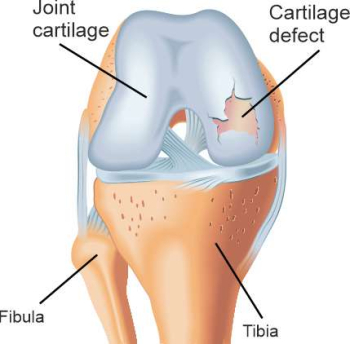
In the case of an accident or a sports injury, sudden pressure and shear forces can lead to localised cartilage defect. This is usually localised in the main stress zone. Frequent causes of chronic cartilage damage in the knee are constant overloads, which occur, for example, due to an incorrect position of the leg axis (knock knees or bow legs), overweight, meniscus damage or instability in the knee joint. Because of the lack of blood supply, cartilage defects cannot heal on its own. If left untreated, cartilage defects leads to arthrosis over time.
Classification of cartilage defects/chondropathy
Depending on the severity, a chondropathy can be divided into several stages. A current and very common classification was developed by the ICRS (International Cartilage Society). It divides chondropathy or cartilage defects into the following grades:
| Grade 0 | normal, no visible defects |
|---|---|
| Grade 1 | Slight softening of the cartilage and/or superficial cracks/fissures in the cartilage |
| Grade 2 | the depth of the cartilage defect reaches less than half (<50%) of the total cartilage thickness |
| Grade 3 | the depth of the cartilage defect reaches more than half (>50%) of the total cartilage thickness |
| Grade 4 | the entire cartilage layer is missing, the bone under the cartilage is exposed |
Symptoms of cartilage defects
In the case of an acute injury with a cartilage defect, there is usually sudden pain and swelling of the joint. Depending on the severity of the cartilage defect and the presence of concomitant injuries, these symptoms can vary in severity. If a piece of cartilage completely detaches during the injury, this piece of cartilage can become trapped in the joint and lead to a blockage. Chronic cartilage damage is usually manifested by pain during or after exercise and recurrent joint swelling. A "rubbing", "cracking" or "creaking" sensation is often felt during movement. Restricted movement is also possible. If the chondropathy or cartilage defect is already more advanced, a so-called start-up pain can occur. This is pain that is strongest at the beginning of a movement (e.g. when standing up after sitting for a long time) and gets better after a short time.
Diagnosis of cartilage defects
An exact assessment of the pain symptoms and a thorough clinical examination can give an indication of cartilage defects. An X-ray examination serves to exclude a bony injury. If the X-ray shows a narrowing of the joint space, this indicates advanced cartilage defects or arthrosis. Finally, a magnetic resonance imaging (MRI) can confirm the diagnosis of cartilage defects or chondropathy. The size and depth of the cartilage defect can be precisely assessed. Before the treatment of cartilage defects in the knee joint, the leg axis should also be determined in an X-ray examination, as a malposition (knock knees or bow legs) can be the cause of the cartilage defect and the malposition must be taken into account in the treatment. In the case of cartilage defects to the kneecap, instability of the kneecap should also be clarified.
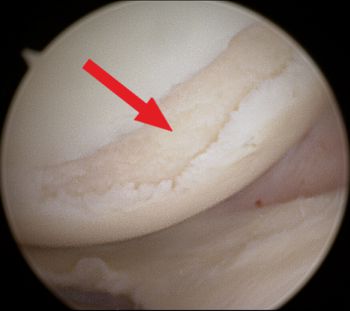
Treatment of cartilage defects
Depending on the extent of the cartilage defect and the pain, it can be treated conservatively, i.e. without surgery (with physiotherapy, infiltrations and medicinal pain therapy), or surgically. Superficial and small cartilage defects (corresponding to low-grade chondropathy) are more suitable for conservative therapy, while large and deep cartilage defects are more likely to require surgery. If a piece of cartilage has completely detached and is moving freely in the joint, this can cause joint block and should definitely be surgically removed or, if possible, refixed.
Conservative therapy
Intensive physiotherapy and muscle building lead to better stability and muscular relief of the joint and consequently to an improvement in symptoms. In addition, food supplements containing joint cartilage ingredients (e.g. chondroitin sulphate, …) can be taken.
Hyaluronic acid infiltrations - "cartilage regeneration"
Hyaluronic acid is an important component of joint cartilage and joint fluid. In addition to its mechanical functions (water storage, pressure resistance, lubricant), it also performs important biochemical functions. Studies have shown that there is a lower concentration of hyaluronic acid in worn (arthritic) joints than in healthy joints.
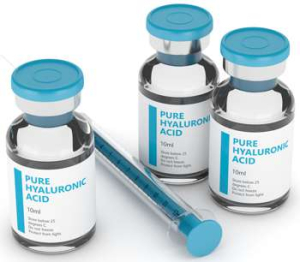
Infiltrations with hyaluronic acid into the joint result in the cartilage being able to store more hyaluronic acid again and the synovial fluid can better perform its function as joint lubricant. In addition, hyaluronic acid has an anti-inflammatory effect and thus blocks enzymes that contribute to cartilage destruction.
Hyaluronic acid infiltrations are administered either 5 times in a row at weekly intervals or once (highly cross-linked hyaluronic acid). The effect usually lasts 6-12 months.
For more information on conservative therapies for cartilage defects, see the cartilage regeneration page.
Surgical therapy
Which surgical therapy is suitable depends above all on the size of the cartilage defect and whether the bone under the cartilage is also injured.
Cartilage smoothing
In cartilage smoothing (shaving), frayed and lifted cartilage is removed during an arthroscopy. However, scientific studies have shown that this procedure alone does not lead to an improvement in the symptoms. For this reason, cartilage smoothing should no longer be performed as an intervention on its own. Exceptions to this are cases where the cartilage has been lifted so much that there is a risk of the piece of cartilage coming loose and joint blockages may result.
Microfracturing
In microfracturing (bone marrow stimulation), small holes are made in the bone below the cartilage defect. Through these holes, bleeding occurs from the bone marrow into the cartilage defect. This bleeding also contains stem cells from the bone marrow, which settle in the area of the cartilage defect and form cartilage replacement tissue there. Microfracturing is particularly suitable for small cartilage defects. The prerequisite for microfracturing is that the bone underneath the cartilage defect is intact.
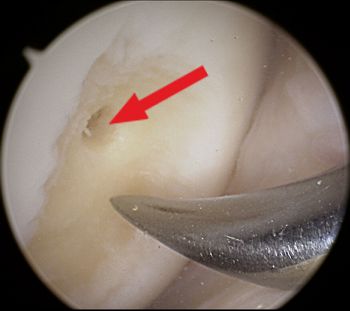
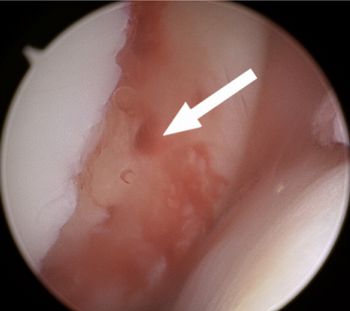
Bone-cartilage transplantation
In bone-cartilage transplantation, cartilage-bone cylinders are taken from an unloaded area of the knee joint and inserted at the site of the cartilage defect. If several such cylinders are used, it is called a mosaicplasty. In contrast to microfracturing, this method can also be used to treat deep defects that extend into the bone. The method is limited by the availability of bone-cartilage cylinders. A defect is created at the removal site, which can cause pain in some cases, even if it is outside the loading zone.
Cartilage cell transplantation
Cartilage cell (chondrocyte) transplantation is particularly suitable for large, well-limited cartilage defects. Cartilage cell transplantation requires two surgical procedures. In the first procedure, tiny pieces of cartilage (biopsies) are taken from an unaffected area of the knee joint during an arthroscopy. Cartilage cells are extracted from these cartilage pieces in the laboratory and propagated. The cultivated cartilage cells are then applied to a biological material that serves as a graft. In the second operation (usually 4-6 weeks after the first operation), the finished cartilage cell transplant is inserted into the cartilage defect. If the cartilage defect is so deep that the underlying bone is also affected (osteochondral defect), the bone defect can be filled with the patient's own bone (e.g. from the iliac crest) and the cartilage cell transplant placed over it. The prerequisite for cartilage cell transplantation is that there is a straight leg axis and intact ligamentous conditions, a large part of the meniscus is present and the opposite cartilage is not too badly damaged.
Cell-free matrix transplantation
In addition to cartilage cell transplantation, there is also the possibility of inserting a biological material without cells as a graft into the cartilage defect. The aim behind this is that the body's own stem cells from the surrounding area settle in the graft and are induced to form cartilage replacement tissue. In contrast to cartilage cell transplantation, only one surgical procedure is necessary.
Special form: Osteochondritis dissecans (OCD)
Osteochondritis dissecans is a special form of cartilage defects in which the bone under the cartilage dies and the bone-cartilage piece can become detached. The reasons for the development of osteochondritis disssecans are not yet fully understood. Mechanical causes are suspected.
At an early stage, osteochondritis disssecans can be treated conservatively with relief and physiotherapy. At the latest when the cartilage-bone piece has detached, it must be surgically removed and the cartilage defect treated with a bone-cartilage transplant, a cartilage cell transplant or a cell-free matrix transplant, depending on the size.
You can find more information about this under its own article: Osteochondritis dissecans
Aftercare
After surgical cartilage therapy, relief or partial weight-bearing is usually necessary. The length depends mainly on the localisation of the cartilage defect and the type of surgical treatment.